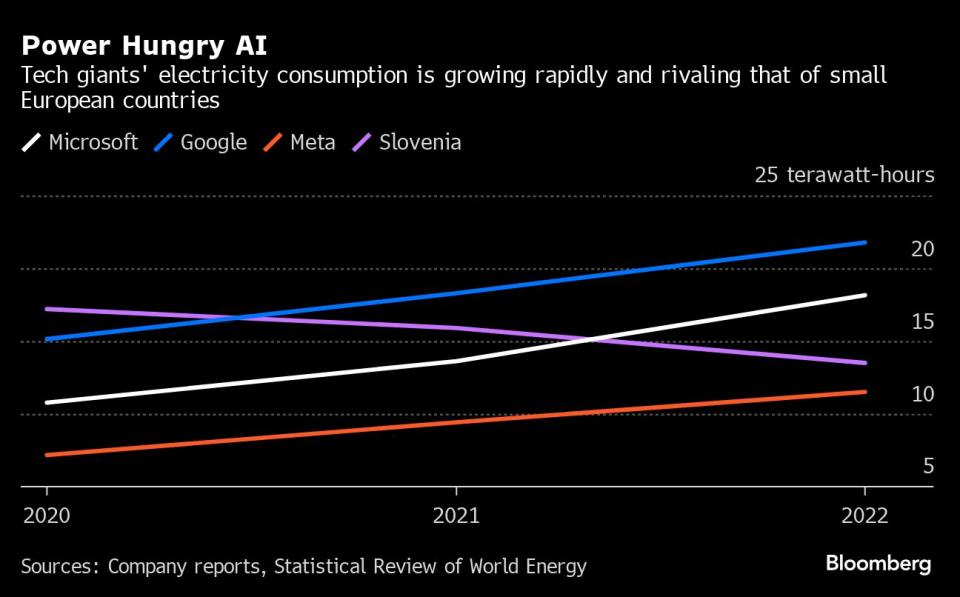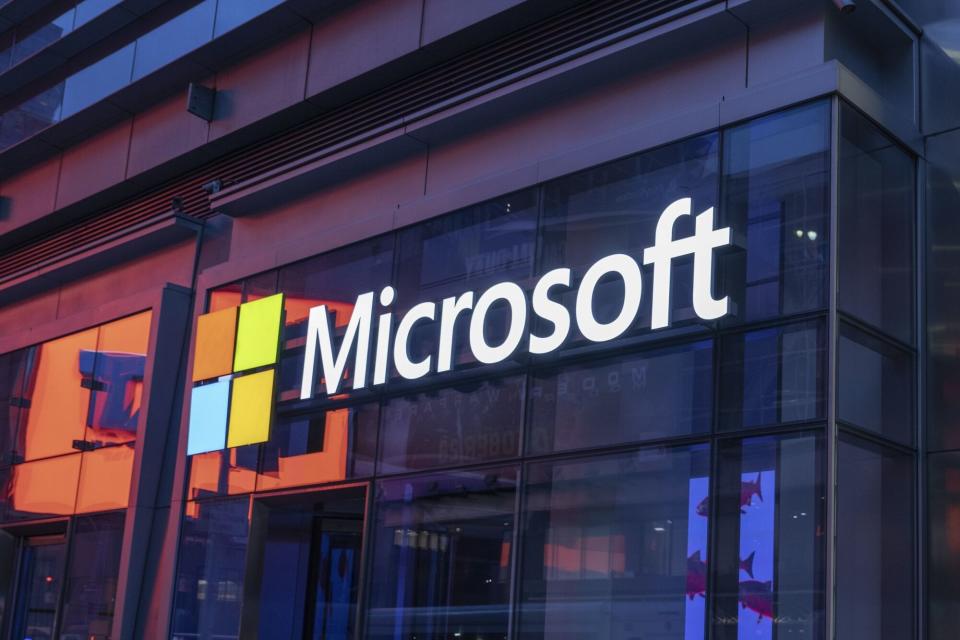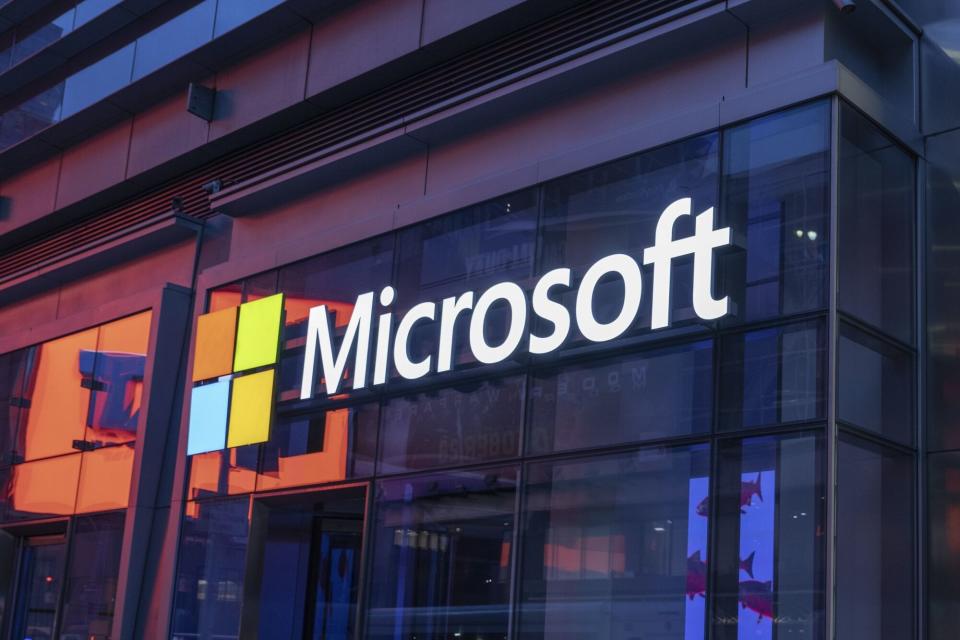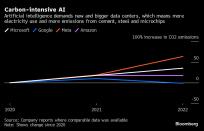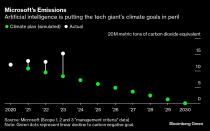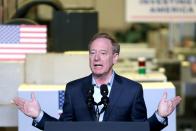Microsoft’s AI Push Imperils Climate Goal as Carbon Emissions Jump 30%
(Bloomberg) -- When Microsoft Corp. pledged four years ago to remove more carbon than it emits by the end of the decade, it was one of the most ambitious and comprehensive plans to tackle climate change. Now the software giant's relentless push to be the global leader in artificial intelligence is putting that goal in peril.
Most Read from Bloomberg
Iran State TV Says ‘No Sign of Life’ at Helicopter Crash Site
Hims Debuts $199 Weight-Loss Shots at 85% Discount to Wegovy
Speedier Wall Street Trades Are Putting Global Finance On Edge
Jamie Dimon Says Succession at JPMorgan Is ‘Well on the Way’
One of the Last Big Bears on Wall Street Turns Bullish on US Stocks
The Seattle-based company’s total planet-warming impact is about 30% higher today than it was in 2020, according to the latest sustainability report published Wednesday. That makes getting to below zero by 2030 even harder than it was when it announced its carbon-negative goal.
Now to meet its goals, the software giant will have to make serious progress very quickly in gaining access to green steel and concrete and less carbon-intensive chips, said Brad Smith, president of Microsoft, in an exclusive interview with Bloomberg Green. “In 2020, we unveiled what we called our carbon moonshot. That was before the explosion in artificial intelligence,” he said. “So in many ways the moon is five times as far away as it was in 2020, if you just think of our own forecast for the expansion of AI and its electrical needs.”
Microsoft’s predicament is one of the first concrete examples of how the pursuit of AI is colliding with efforts to cut emissions. Choosing to capitalize on its early lead in the new market for generative AI has made Microsoft the most valuable company in the world, but its leaders also acknowledge keeping up with demand will mean investing more heavily in polluting assets.
AI products are power hungry and data-processing heavy. That first increases the workload of existing centers, which increases energy use. But such is the demand that, to keep up, Microsoft has to also build new data centers. That requires carbon-intensive cement, steel and microchips.
The tech giant plans to spend more than $50 billion between July 2023 and June of this year on expanding its data centers to meet rising demand for AI products. That number for the next 12 months, starting in July, is expected to be even higher, Chief Financial Officer Amy Hood said in an interview last month. Since February, the company has touted new data center projects in Wisconsin, Thailand, Indonesia, Spain, Germany and Japan.
Smith believes the good AI can do for the world will outweigh its environmental impact. “We fundamentally believe that the answer is not to slow down the expansion of AI but to speed up the work needed to make it more environmentally friendly,” said Smith. “I guarantee there’s one way to fail: It’s to give up.”
Some Microsoft employees are speaking out about the company’s other AI-related work to enhance oil extraction. More than 10,000 employees have formed a group that wants Microsoft to reduce its global warming impact, and some have quit in protest. “Work to maximize oil production with our technology is negating all of our good work, extending the age of fossil fuels, and enabling untold emissions,” wrote two former employees. “We are both deeply saddened to be so let down by a company we loved so much.”
“Employees around the world are core to our sustainability mission,” a spokesperson for Microsoft said in response. “Our focus is empowering the energy transition.”
This isn’t a challenge for Microsoft alone. Its competitors in the AI race are Alphabet Inc.’s Google, Meta Platforms Inc. and Amazon.com Inc.—companies that all set ambitious climate goals but have seen their total emissions increase.
In response to questions, a Google spokesperson said that predicting increase in energy use and emissions tied to AI is hard and said the company is trying reduce the company’s environmental impact by increasing deployment of clean energy and buying credits for carbon removal, among other steps. An Amazon spokesperson said “we remain committed” to reaching net-zero by 2040 and touted its work on enabling new clean energy sources, including nuclear. Meta did not respond.
Despite AI's ravenous energy consumption, this actually contributes little to Microsoft's hike in emissions — at least on paper. That's because the company says in its sustainability report that it's 100% powered by renewables.
Companies use a range of mechanisms to make such claims, which vary widely in terms of credibility. Some firms enter into long-term power purchase agreements (PPAs) with renewable developers, where they shoulder some of a new energy plant's risk and help get new solar and wind farms online. In other cases, companies buy renewable energy credits (RECs) to claim they're using green power, but these inexpensive credits do little to spur new demand for green energy, researchers have consistently found.
Microsoft uses a mix of both approaches. On one hand, it's one of the biggest corporate participants in power purchase agreements, according to BloombergNEF, which tracks these deals. But it's also a huge purchaser of RECs, using these instruments to claim about half of its energy use is clean, according to its environmental filings in 2022. By using a large quantity of RECs, Microsoft is essentially masking an even larger growth in emissions.
“It is Microsoft’s plan to phase out the use of unbundled RECs in future years,” a spokesperson for the company said. “We are focused on PPAs as a primary strategy.”
So what else can be done? Smith, along with Microsoft’s Chief Sustainability Officer Melanie Nakagawa, has laid out clear steps in the sustainability report. High among them is to increase efficiency, which is to use the same amount of energy or computing to do more work. That could help reduce the need for data centers, which will reduce emissions and electricity use. On most things, “our climate goals require that we spend money,” said Smith. “But efficiency gains will actually enable us to save money.”
Microsoft has also been at the forefront of buying sustainable aviation fuels that has helped reduce some of its emissions from business travel. The company also wants to partner with those who will “accelerate breakthroughs” to make greener steel, concrete and fuels. Those technologies are starting to work at a small scale, but remain far from being available in commercial quantities even if expensive.
Cheap renewable power has helped make Microsoft’s climate journey easier. But the tech giant’s electricity consumption last year rivaled that of a small European country—beating Slovenia easily. Smith said that one of the biggest bottlenecks for it to keep getting access to green power is the lack of transmission lines from where the power is generated to the data centers. That’s why Microsoft says it’s going to increase lobbying efforts to get governments to speed up building the grid.
Despite all these efforts, what if Microsoft’s emissions remain high in 2029? Smith said that bulk purchases of carbon removal credits “is always a possibility, but I don’t think it’s the desired course.”
There are a myriad ways to remove carbon dioxide from the air—from devices with large fans and industrial chemicals to planting trees. But these credits carry a premium price, many times more than $100 per ton that Microsoft applies as an internal carbon tax on its business travel.
“You’ve got to be willing to invest and pay for it,” said Smith. Climate change is “a problem that humanity created and that humanity can solve.”
--With assistance from Ben Elgin.
Most Read from Bloomberg Businessweek
Netflix Had a Password-Sharing Problem. Greg Peters Fixed It
Millennium Covets Citadel-Size Commodities Gains, Just Not the Risk
©2024 Bloomberg L.P.

 Yahoo Finance
Yahoo Finance 